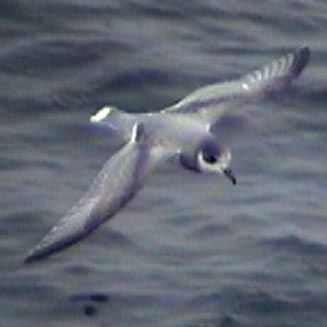|
Halobaena caerulea (Blue
petrel)
Bloustormvoël [Afrikaans]; Blauwe stormvogel [Dutch];
Prion bleu [French]; Blausturmvogel [German]; Painho-azul [Portuguese]
Life
> Eukaryotes >
Opisthokonta
> Metazoa (animals) >
Bilateria >
Deuterostomia > Chordata >
Craniata > Vertebrata (vertebrates) > Gnathostomata (jawed
vertebrates) > Teleostomi (teleost fish) > Osteichthyes (bony fish) > Class:
Sarcopterygii (lobe-finned
fish) > Stegocephalia (terrestrial
vertebrates) > Tetrapoda
(four-legged vertebrates) > Reptiliomorpha > Amniota >
Reptilia (reptiles) >
Romeriida > Diapsida > Archosauromorpha > Archosauria >
Dinosauria
(dinosaurs) > Saurischia > Theropoda (bipedal predatory dinosaurs) >
Coelurosauria > Maniraptora > Aves
(birds) > Order: Ciconiiformes
> Family: Procellariidae
 |
|
|
Blue petrel, between South Orkney and South
Georgia, Sub-Antarctic. [photo
Teus
Luijendijk ©] |
|
Distribution and habitat
Breeds from August-February on the Diego Ramirez Islands,
other islands off the Cape Horn and sub-Antarctic Islands, after which it
disperses across the Southern Ocean, mainly from 40-70° South. It occasionally
moves en masse to southern African waters, where it can be found off the
coast of South Africa, however this does not happen often. In the most
well-known irruption, at least 76 individuals travelled to southern African
waters between July-August 1984, mirroring similar occurrences off Australasia
and South America.
Food
It mainly eats crustaceans, fish, salps and squid, doing
most of its foraging by grabbing prey from the surface of the water. It often
follows ships to catch the food they drop, or alternatively it can follow
dolphins and catch the animals they disturb. The following food items have been recorded
in its diet:
- crustaceans
- euphausiids
- amphipods
- copepods
- squid
- fish
- salps
Threats
Not threatened, in fact it has been negatively affected by
introduced Domestic cats (Felis catus) at its breeding colonies.
References
-
Hockey PAR, Dean WRJ and Ryan PG 2005. Roberts
- Birds of southern Africa, VIIth ed. The Trustees of the John Voelcker
Bird Book Fund, Cape Town.
|
